Class 6 Maths Chapter -5 Understanding Elementary Shapes
Exercise 5.1
Question 1: What is the disadvantage in comparing line segments by mere observation?
Answer: When we compare two line segments of almost same lengths, we cannot be sure about the line segment of greater length. Therefore, it is not an appropriate method to compare line segments having a slight difference between their lengths. Therefore, this is the disadvantage in comparing line segments by mere observation.
Question 2: Why is it better to use a divider rule than a ruler, while measuring the length of a line segment?
Answer: While using a ruler, due to incorrect positioning of the eye positioning error may occur. Therefore, it is better to use the divider rule than a ruler, while measuring the length of a line segment.
Question 3: Draw any line segment, say  . Take any point R lying in between P and Q. Measure the lengths of PQ, QR and PR. Is PQ = PR + RQ?
. Take any point R lying in between P and Q. Measure the lengths of PQ, QR and PR. Is PQ = PR + RQ?
[Note: If P, Q, R are any three points on a line such that PR + RQ = PQ, then we can be sure that R lies between P and Q]
Answer: It is given that point R is lying somewhere in between P and Q. Therefore all these points are lying on the same line segment ![]() . Hence, for every situation in which point R is lying in between P and Q, it may be said that PQ =PR + RQ.
. Hence, for every situation in which point R is lying in between P and Q, it may be said that PQ =PR + RQ.
For example,
![]() is a line segment of 6 cm and R is a point between P and Q , such that it is 2 cm away from point Q. We can find that the measure of line segment PR⎯ comes to 4 cm. Hence, relation PQ =PR + RQ is verified.
is a line segment of 6 cm and R is a point between P and Q , such that it is 2 cm away from point Q. We can find that the measure of line segment PR⎯ comes to 4 cm. Hence, relation PQ =PR + RQ is verified.
Question 4: If P, Q and R: are three points on a line such that PQ = 5 cm, QR = 3 cm and PR = 8 cm, which one of them lies between the other two?
Answer:
Given that,
PQ = 5 cm
QR = 3 cm
PR = 8 cm
Here, PR = PQ + QR
Therefore, point Q is lying between P and R.
Question 5: Verify, whether D is the midpoint of  .
.

Answer:
Given,
![]() = 4 – 1 = 3 units
= 4 – 1 = 3 units
![]() = 7 – 4 = 3 units
= 7 – 4 = 3 units
![]() = 7 – 1 = 6 units
= 7 – 1 = 6 units
∴ D is the mid point of ![]() .
.
Question 6: If Q is the midpoint of ![]() and R is the midpoint of
and R is the midpoint of ![]() , where P, Q, R, S lie on a straight line, say why PQ = RS?
, where P, Q, R, S lie on a straight line, say why PQ = RS?
Answer:
Since Q is the midpoint of PR,
PQ = QR (1)
Since R is the midpoint of QS,
QR = RS (2)
From equations (1) and (2),
We may find that
PQ = RS
Exercise 5.2
Question 1: As a clockwise revolution, what fraction does the hour hand of a clock turn through, when it moves from:
(a) 3 to 9
(b) 4 to 7
(c) 7 to 10
(d) 12 to 9
(e) 1 to 10
(f) 6 to 3
Answer:
(a) 1⁄2 or two right angles.
(b)1⁄4 or one right angles.
(c) 1⁄4 or one right angles.
(d) 3⁄4 or three right angles.
(e) 3⁄4 or three right angles.
(f) 3⁄4 or three right angles.
Question 2: Where will the hand of a clock stop if it is:
(a) Starting at 12 and make 1⁄2 of a revolution, which is clockwise?
(b) Starting at 2 and makes 1⁄2 of a revolution, which is clockwise?
(c) Starting at 5 and makes 1⁄4 of a revolution, which is clockwise?
d) Starting 5 and makes 3⁄4 of a revolution, which is clockwise?
Answer:
(a) At 6
(b) At 8
(c) At 8
(d) At 2
Question 3: If you stand facing following cases, what fraction of revolution would have you been moved:
(a) East and turn clockwise to face north?
(b) South and turn clockwise to face east?
(c) West and turn clockwise to face east?
Answer:
(a) 3⁄4
(b) 3⁄4
(c) 1⁄2
Question 4: Find the number of right angles turned through by the hour hand of a clock when it goes from:
(a) 3 to 6
(b) 2 to 8
(c) 5 to 11
(d) 10 to 1
(e) 12 to 9
(f) 12 to 6
Answer:
(a) One right angle
(b) Two right angles
(c) Two right angles
(d) One right angle
(e) Three right angles
(f) Two right angles
Question 5: How many right angles do you make if you start facing:
(a) South and turn clockwise to west?
(b) North and turn anti-clockwise to east?
(c) West and turn to west?
(d) South and turn to north?
Answer:
(a) One right angle
(b) Three right angles
(c) Four right angles
(d) Two right angles
Question 6: Where will the hour hand of a clock stop if it starts:
(a) From 6 and turns through 1 right angle?
(b) From 8 and turns through 2 right angles?
(c) From 10 and turns through 3 right angles?
(d) From 7 and turns through 2 straight angles?
Answer:
(a) At 9
(b) At 2
(c) At 7
(d) At 7
Question 7: Which direction will you face if you start facing:
(a) East and make 1⁄2 of a revolution clockwise?
(b) East and make 11⁄2 of a revolution clockwise?
(c) West and make 3⁄4 of a revolution, clockwise?
(d) South and make one full revolution?
Answer:
(a) West
(b) West
(c) North
(d) South
Exercise 5.3
Question 1: Match the correct options
| A) Straight angle | i) Less than one-fourth of a revolution |
| B) Right angle | ii) More than half a revolution |
| C) Acute angle | iii) Half of a revolution |
| D) Obtuse angle | iv) One-fourth of a revolution |
| E) Reflex angle | v) Between 1⁄4 and 1⁄2 of a revolution |
| vi) One complete revolution |
Answer:
A) Straight angle — iii) Half of a revolution
Reason
1800 is considered as a straight line and half of the revolution is also 1800
B) Right angle — iv) One-fourth of a revolution
Reason
900 is considered as a straight line and half of the revolution is also 900.
C) Acute angle — i) Less than one-fourth of a revolution
Reason
The angle which is less than 900 is called acute angle and also less than one-fourth of a revolution is the angle less than 900
.D) Obtuse angle — v) Between 1⁄4 and 1⁄2 of a revolution
Reason
The angle which is greater than 900 and less than 1800 is called obtuse angle and also the value between1⁄4 and 1⁄2of a revolution also lies between 900 and 1800
E) Reflex angle – ii) More than half a revolution
Reason
The angle which is greater than 1800 but less than 3600 is called reflex angle and also more than half a revolution is the angle whose measure is greater than 1800.
Question 2: Classify the following angles as ( Right/Reflex/Obtuse/Acute)
a)
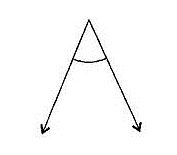
Answer:
Acute angle ( less than 900 )
(b)
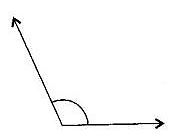
Answer:
Obtuse angle (greater than 900 and less than 1800)
(c)
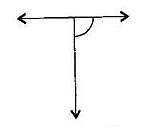
Answer:
Right angle (equals 900)
(d)
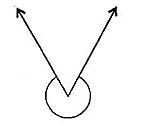
Answer:
Reflex angle (greater than 1800 but less than 3600)
(e)
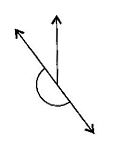
Answer:
Straight angle (equals 1800)
(f)
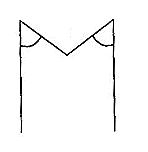
Answer:
Acute angle ( less than 900 )
Exercise 5.4
Question 1: Measure the following:
(i) A right angle
Ans. Right angle measures 900
(ii) A straight line
Ans: Straight line measures 1800
Question 2: State whether the following are True or False:
(i) Acute angle measures less than 900.
Answer: True
(ii) Obtuse angle measures less than 900.
Answer: False
Obtuse angle measures greater than 900.
(iii) Reflex angle measures greater than 1800
Answer: True
(iv) One complete revolution measures 3600.
Answer: True
(v) If n∠x = 540 and m∠y = 360, then n∠x is greater than m∠y.
Answer: True
Question 3: Give the measures for the following:
(i) Acute angles
Answer: 300. , 800.
(ii) Obtuse angles
Answer: 1200. , 1500.
Question 4: Using protractor measure the given and note them down.
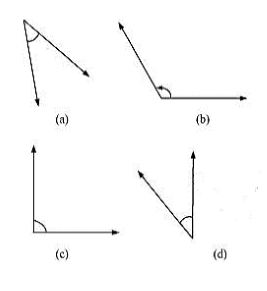
Answer:
400.
1300.
900.
600., 1500. and 750.
Question 5: Measures the largest angle and find their angles.
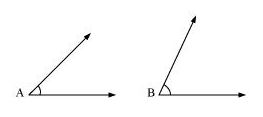
Answer:
A measures 400.
B measures 600.
∠A has the largest angle.
Question 6: Measure the largest angle and find their angles.
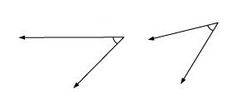
Answer: The angles measure 750 and 700.
Hence, the first angle is greater.
Question 7: Fill in the following:
(i) An angle which is less than 900 is _________
Answer: Acute angle
(ii) An angle which is greater than 900 is ________
Answer: Obtuse angle
(iii) An angle which is sum of two right angle is __________
Answer: Straight Angle
(iv) If the sum of two angles is 900, then each of the individual angles is ________
Answer: Acute angle.
(v) If the sum of two angles is 1800 and one angle is obtuse, then the other angle is ________
Answer: Acute angle
Question 8: Using protractor measure the following:
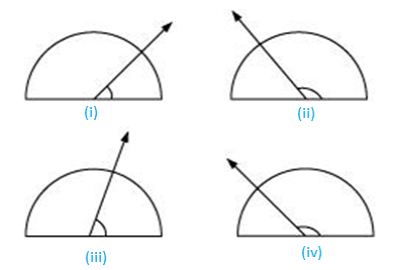
Answer:
The angle measures
(i) 300.
(ii)1200.
(iii) 600.
(iv) 1800.
Question 9: What is the angle between the two hands of the clock?
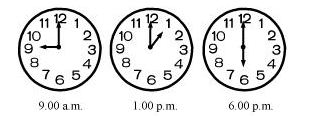
Answer:
(i) 900.
(ii) 300.
(iii) 1800.
Question 10: The measure of the angle is 450. Looking through a magnifying glass, does the angle becomes larger? Do the size increases?
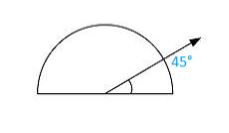
Answer: The angle does not change.
Question 11: Measure and identify the following:
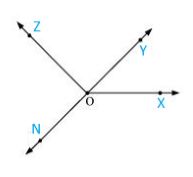
| Angle | Measure | Type |
| ∠XOY | – | – |
| ∠XOZ | – | – |
| ∠YOZ | – | – |
| ∠NOZ | – | – |
| ∠NOX | – | – |
| ∠NOY | – | – |
Answer:
| Angle | Measure | Type |
| ∠XOY | 500. | Acute |
| ∠XOZ | 1300 | Obtuse |
| ∠YOZ | 800. | Acute |
| ∠NOZ | 1000. | Obtuse |
| ∠NOX | 1450 | Obtuse |
| ∠NOY | 1800 | Straight |
Exercise 5.5
Question 1: Find out the models for the scenarios that are perpendicular lines;
(a) Edges of table top that are adjacent
(b) Railway track lines
(c) Segments of line that are forming the letter ‘L’.
(d) V letter.
Answer:
(a)Perpendicular
(b) Not perpendicular
(c) Perpendicular
(d) Not perpendicular
Question 2: Let ![]() be the perpendicular to the line segment
be the perpendicular to the line segment ![]() .Let
.Let ![]() and
and ![]() intersect in the point A. What is the measure of ∠PAY ?
intersect in the point A. What is the measure of ∠PAY ?
Answer:
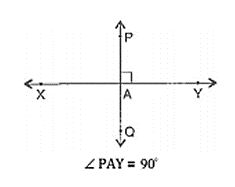
∠PAY=900
Question 3: Find out the measures of the angles that are formed by using two set-squares that are present in geometry box? Is there any angle measure that is common?
Answer: The angles present in the first set-square are 450, 900, 450 and another set-square has 600, 900, 300. The common angle between them is 900.
Question 4: Analyze the diagram. The line l is perpendicular to line m.
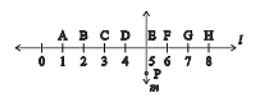
(a) Is line CE equal to EG?
(b) Does PE cut CG in two equal halves?
(c)Find out the line segment which are perpendicularly bisected by PE
(d) Identify whether true or false? (i) CD=GH (ii)BCFG
Answer:
(a) Yes, the measure of both is 2 units.
(b) Yes, because CE=EG
(c) ![]()
(d) (i)True , (ii) True , (iii) True
Exercise 5.6
Question 1: Name the triangles types given below-:
(i) Triangle with lengths of sides 8.7 cm, 7 cm and 6 cm.
(ii) ΔPQR with PQ = 9cm, PR = 8cm and QR = 7cm.
(iii) ΔABC such that AB= BC = AC = 6 cm.
(iv) ΔXYZwithn∠X=900
(v) ΔDEFwithn∠E=900 and DE = EF
(vi) ΔKLMwithn∠K=300,n∠L=700 andn∠M=800
Answer:
(i) Scalene triangle
(ii) Scalene triangle
(iii) Equilateral triangle
(iv)Right-angled triangle
(v) Isosceles right-angled triangle
(vi Acute-angled triangle
Question 2: Match the following-:
| Measure of Triangle | Types of Triangle |
| (a) 2 sides having equal length | (i) Isosceles right angle |
| (b)3 sides having equal length | (ii) Right angle |
| (c)1 right angle | (iii) Scalene |
| (d)3 acute angles | (iv) Equilateral |
| (f)All the sides with different length | (v) Obtuse angle |
| (g)1 right angle having two sides of equal length | (vi) Acute angle |
| (g) 1 obtuse angle | (vii) Isosceles |
Answer:
| Measure of Triangle | Types of Triangle |
| (a) 2 sides having equal length | (vii) Isosceles |
| (b)3 sides having equal length | (iv) Equilateral |
| (c)1 right angle | (ii) Right angle |
| (d)3 acute angles | (vi) Acute angle |
| (f)All the sides with different length | (iii) Scalene |
| (g)1 right angle having two sides of equal length | (i) isosceles right angle |
| (g) 1 obtuse angle | (v) Obtuse angle |
Question 3: Given below are the triangles, Name them in two different ways-:
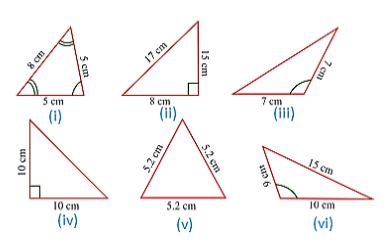
Answer:
(i) Isosceles triangle and Acute angled triangle
(ii) Scalene triangle and Right-angled triangle
(iii) Isosceles triangle and Obtuse-angled triangle
(iv)Isosceles triangle and Right-angled triangle
(v) Acute angled triangle and Equilateral triangle
(vi)Scalene triangle and Obtuse-angled triangle
Question 4: Try out constructing triangles by using matchsticks as shown below.
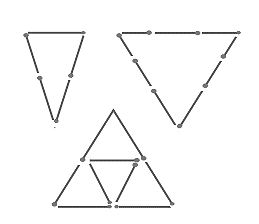
Can a triangle be made using-:
(i) 3 matchsticks
(ii) 4matchsticks
(iii) 5 matchsticks
(iv) 6 matchsticks
(All the available matchsticks are to be used in each case)
If a triangle is not formed, then try to give specific reasons for that.
Answer:
(i) For 3 matchsticks An acute angle triangle is formed with 3 matchsticks because the sum of the two sides is greater than the third side.
(ii) For 4 matchsticks By using 4 matchsticks a square is formed, so therefore it is not possible in this case.
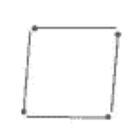
(iii) For 5 matchsticks An acute angle triangle is formed with the help of 5 matchsticks because in this case the sum of the two sides is greater than the third side.
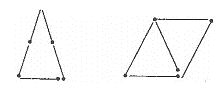
(iv) For 6 matchsticks An acute angle triangle is formed with the help of 6 matchsticks because in this case the sum of the two sides is greater than the third side.

Exercise 5.7
Question 1:
Indicate the following as true or false-:
(i) In a rectangle, each angle is a right angle.
(ii) In a rectangle, the opposite sides are equal in length.
(iii) In a square, the diagonals are perpendicular to each another.
(iv) In a rhombus, all the sides are equal in length.
(v) In a parallelogram, all the sides are equal in length.
(vi) In a trapezium, the opposite sides are parallel.
Answer:
(i) In a rectangle, each angle is a right angle. => TRUE
(ii) In a rectangle, the opposite sides are equal in length. => TRUE
(iii) In a square, the diagonals are perpendicular to each another. => TRUE
(iv) In a rhombus, all the sides are equal in length. => TRUE
(v) In a parallelogram, all the sides are equal in length. => FALSE
(vi) In a trapezium, the opposite sides are parallel. => FALSE
Question 2: State a specific reason for the given statements-:
(i) We can consider a square as a special type of rectangle.
(ii) We can consider a rectangle as a special type of parallelogram.
(iii) We can consider a square as a special type of rhombus.
(iv) Rectangles, Parallelograms and Squares all can be considered as a quadrilateral.
(v) Square can also be called as a Parallelogram.
Answer:
(i) A square also follow the properties of a rectangle as its opposite sides are equal also all the angles are right angled.
(ii) A rectangle also have its opposite sides equal as well as parallel.
(iii) In a rhombus all the sides are equal also diagonals are perpendicular to each other. And square have the same property.
(iv) All the above shapes are having four sides each.
(v) A square also have its opposite sides equal as well as parallel.
Question 3: In a regular figure all the angles should be equal and all the sides in the figure need to be same. Identify among the given figures which of them are regular quadrilateral.
Answer: A square is a quadrilateral.
Exercise 5.8
Question 1: Identify whether the given shapes are polygons. If not, give reasons?

Answer:
(a) As the figure is not closed, therefore, the shape is not a polygon.
(b) As it is closed by line segments hence it is a polygon.
(c) As it is not made of line of segments it is not a polygon.
(d)As it has curved surface and also is made up of line of segments.
Question 2:Name each polygon:
Answer:
(a) Quadrilateral
(b) Triangle
(c) Pentagon
(d) Octagon
Question 3: Give a sketch of a regular hexagon. Connecting its vertices, and by drawing a triangle. Identify the type of the triangle you have drawn.
Answer: 123456 is a regular hexagon and triangle thus formed by joining 165 is an isosceles triangle.
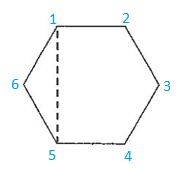
Question 4: Draw a rough sketch of a regular hexagon. Connecting any three of the given vertices, draw a regular triangle. Identify the type of the triangle you have drawn.
Answer: 12345678 is a regular shaped octagon and 3456 is a regular shaped rectangle.
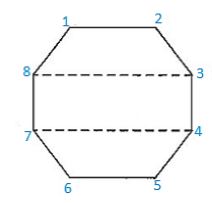
Question 5: The line segment from the diagonal joins the any of two vertices in the polygon and is not in the side of the given polygon. Give rough sketch pentagons by drawing its diagonals.
Answer: 12345 is the required pentagon and its diagonals are 1 4, 1 3, 2 5 and 2 4.
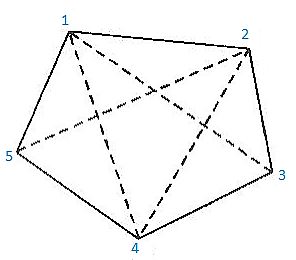
Exercise 5.9
Question 1: Match the following:
| (a) Cone |  |
| (b) Sphere | 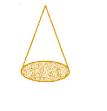 |
| (c) Cylinder |  |
| (d) Cuboid |  |
| (e) pyramid |  |
Answer:
| (a) Cone |  |
| (b) Sphere |  |
| (c) Cylinder |  |
| (d) Cuboid |  |
| (e) pyramid |  |